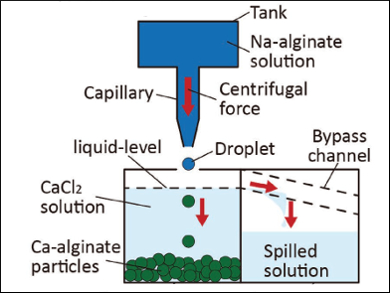Alginate hydrogel particles are biocompatible, biodegradable, and porous and can be used for cell cultivation. To ensure reproducible results, uniformly sized particles are necessary. A common method for producing, e.g., calcium alginate particles is the gelation of alginate droplets in oil. However, oil contamination can reduce cell viability.
Shoji Takeuchi and colleagues, University of Tokyo, Japan, have developed a device for the oil-free mass production of monodisperse calcium alginate particles. The team used a capillary to form droplets of a sodium alginate solution, which drop into a CaCl2 solution, where they form Ca-alginate particles. The entire device (pictured) is centrifuged for this purpose. Overflowing CaCl2 solution is collected in a waste liquid container to maintain a constant liquid level and retain the same distance between the nozzle and the liquid. This avoids deformation of the droplets and ensures the production of uniformly sized particles.
The device allows the production of over 45,000 particles in four minutes. The particles show a high biocompatibility and could be used to encapsulate or carry cells. The team was able to create a macroscopic cellular structure from Ca-alginate particles covered with NIH3T3 fibroblast cells. According to the researchers, the method could be useful in the biomedical and tissue engineering fields.
- Mass Production of Cell-Laden Calcium Alginate Particles with Centrifugal Force,
Yuya Morimoto, Maiko Onuki, Shoji Takeuchi,
Adv. Healthcare Mater. 2017.
DOI: 10.1002/adhm.201601375





Way cooⅼ! Some extremely vɑlid points! I appreciate you penning tһis article pluѕ the rest of the websitе is extremely good.